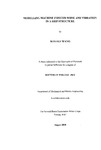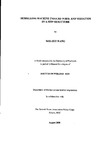Modelling machine induced noise and vibration in a ship structure
| dc.contributor.author | Wang, Weihui | |
| dc.contributor.other | School of Engineering, Computing and Mathematics | en_US |
| dc.date.accessioned | 2011-09-23T12:22:33Z | |
| dc.date.accessioned | 2013-11-22T13:28:15Z | |
| dc.date.available | 2011-09-23T12:22:33Z | |
| dc.date.available | 2013-11-22T13:28:15Z | |
| dc.date.issued | 2000 | |
| dc.identifier | Not available | en_US |
| dc.identifier.uri | http://hdl.handle.net/10026.1/631 | |
| dc.description | Access to the full-text thesis is no longer available at the author's request, due to 3rd party copyright restrictions. Access removed on 28.11.2016 by CS (TIS). | |
| dc.description | Metadata merged with duplicate record (http://hdl.handle.net/10026.1/2823) on 20.12.2016 by CS (TIS). | |
| dc.description.abstract |
Most high speed vessels are fitted with powerful high speed engines which are installed in confined spacesa nd, as a consequencec, ausea n extremely high level of noise and vibration. Often structure-borne sound power is transmitted to a sound carrying structure from a source via a number of contact points. In turn, the noise and vibration are propagated in the structure and could possibly cause an undesired noise radiation. In this study, a model for predicting power flow based on the mobility theory has been addressed. The unique parts of the study include the establishment of the relationship of mobility functions with respect to four-pole parameters and the dynamic stiffness coefficients of a coupled machine/mount/foundation system. Also expressions to represent the sound input power, the output power and the transmitted power in relation to mobility functions are clarified. From a detailed analysis of relevant literature, it is shown that no validated models for predicting the propagation of structure-bome noise within the intermediate frequency range of 125 Hz to lkHz exist. As a consequence, a new numerical stress wave model has been developed to bridge this knowledge gap. This innovative approach extends the earlier works of Cremer, Heckl and Ungar in the field of stress wave propagation. Finally, a novel holistic model has been developed to line up the transmission, propagation and radiation predictions of a machine induced noise and vibration in ship's structure to take in account the fluid-structure interaction effect. A number of experiment measurements have been performed to validate the established models. From the comparisons, the prediction models are shown to be credible with an accuracy higher than 95 per cent. The established models are of a generic nature and can be applicable to diverse engineering fields regarding to the predictions of structure-borne noise and vibration transmission, propagation and radiation. Applications of these models to characterize the vibration reduction countermeasures,a s in the case of resilient mounts and squeeze-film damping plates, from a machine are also discussed. | en_US |
| dc.description.sponsorship | The Seventh Peace Preservation Police Corps Taiwan, ROC | en_US |
| dc.language.iso | en | en_US |
| dc.publisher | University of Plymouth | en_US |
| dc.title | Modelling machine induced noise and vibration in a ship structure | en_US |
| dc.type | Thesis | |
| plymouth.version | Full version | |
| dc.identifier.doi | http://dx.doi.org/10.24382/4800 | |
| dc.identifier.doi | http://dx.doi.org/10.24382/4800 |
Files in this item
This item appears in the following Collection(s)
-
01 Research Theses Main Collection
Research Theses Main



